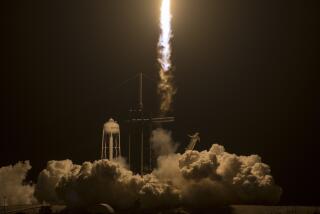NASA Presses Search for Cause of Shuttle Leak
- Share via
IRVINE — NASA engineers Monday continued to search for the cause of a hydrogen leak that has grounded the nation’s space-shuttle fleet, conducting further tests of a fuel assembly partially manufactured by Parker Bertea Aerospace here.
Officials of the National Aeronautics and Space Administration said the problem is located somewhere around the so-called “umbilical-disconnect” system that links the external liquid hydrogen fuel tank with the shuttle orbiter’s main engines.
The disconnect system, which consists of a series of pipes and valves that are joined by matching plates, is designed to allow the separation of the fuel tank and the orbiter in mid-flight.
A hydrogen fuel leak was first discovered in May on the space shuttle Columbia, and NASA decided on Friday to ground all three shuttles when a similar problem turned up on the Atlantis. NASA conducted another series of tests Monday on the Atlantis, which remains on the launch pad at the Kennedy Space Center in Florida, and will discuss the results today.
Irvine-based Parker Bertea builds the 17-inch-diameter main fuel assembly that lies at the heart of the umbilical-disconnect system. In a press release Monday, NASA said that the leak “appears to be primarily from the 17-inch line but possibly with a contribution from the 4-inch line.” The large main valves on the 17-inch line, one on the orbiter side of the disconnect assembly and one on the tank side, are considered prime suspects in the problem.
It could not be determined Monday who makes the 4-inch line, which is used to recirculate the hydrogen while the tank is filled.
Other pieces of the disconnect system, including the matching plates, are made by a number of different contractors, and the entire assembly is put together and tested by shuttle prime contractor Rockwell International Corp.
NASA officials also said the problem could have resulted not from any flaws in the disconnect system, but from a slight misalignment of the orbiter and the fuel tank.
The 17-inch disconnect assembly consists of 582 different pieces, according to Parker Bertea spokesman Richard Charlton, and was modified slightly after the Challenger explosion to assure that the fuel connection could never be cut off accidentally.
“Every test to date shows the problem is not in the disconnect,” Charlton said.
Charlton said the 17-inch assemblies were tested at the Parker Bertea plant here using liquid nitrogen at a temperature of about minus 320 degrees Fahrenheit. Then they were shipped to Rockwell’s Downey facility, one of the few locations in the country where tests can be conducted using liquid hydrogen at minus 423 degrees, and subjected to the more severe hydrogen tests.
A Rockwell spokesman said the external tank side of the disconnect assembly from Colombia was flown back to Downey several weeks ago, and tests so far have not revealed any problems. The orbiter side of the Colombia assembly arrived in Downey on Saturday, and the two sides will be “mated” on a special stand for a series of tests beginning Thursday.
Parker Bertea, a subsidiary of Parker Hannifin Corp. of Cleveland, began work several months ago on a new design for the disconnect assembly, but Charlton said that work was unrelated to any possible flaws in the existing system, whose design dates to 1974.
The new fuel assembly, which will feature a 14-inch rather than a 17-inch line, will not be completed until mid-1993, he said.
Parker Bertea has annual aerospace revenues of about $700 million, of which less than 5% are related to NASA programs, Charlton said. The company makes 14 different components for the space shuttle, the fuel assembly being the largest.
More to Read
Sign up for Essential California
The most important California stories and recommendations in your inbox every morning.
You may occasionally receive promotional content from the Los Angeles Times.













